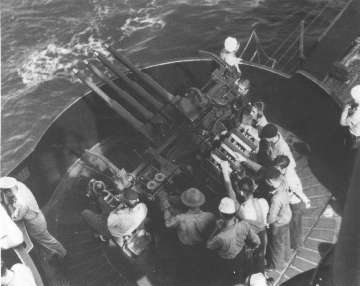

The 1'1" gun traced its origin back to the 1928-1929 years, when the Bureau of Ordonance set up a board on light machine guns. In 1933, the first guns were test fired, and a quadruple mount was ordered to amass the firepower of the gun so that even though it was slow firing it would be able to shoot down a fast approaching plane.
Compared to the then-standard .50 caliber gun, the 28mm gun had important advantages: longer range; heavier projectile; and faster muzzle velocity. Most important was the explosive projectile that the 28mm gun fired, which allowed for less hits to bring down an airplane.
When in April 1935 the first quadruple mount was turned out by the Naval Gun Factory, it was a complex design that had serious teething problems. It could traverse at any elevation to up to 30° while having an elevation of 110° max. Problems were with vibration, the traverse, and jamming.
The 28mm
main problem was that it could not really stop planes in 1942, and that
it was, compared to its stopping power, and compared to the easiness of
handling and lightness of the 20mm Oerlikon, clearly an insufficent weapon.
It remained in service aboard destroyer escorts and other small vessels
to the end of the war but had no impact whatsoever on later air battles.
|
|
Year of Construction:
1928
Bore: 28mm Total weight: 4762kg / 10500lbs Weight of barrel: 49kg / 108 lbs Length of gun: 3037.3mm / 119.58 ins. Length of bore: 2082.8mm / 82 ins. (74 calibers) Wt. of projectile: 0.41 kg / 0.917 lbs Max. Range: 6.77 km / 7400 yds at 41° elevation Ceiling: 5.790 km / 19.000 ft. at 90° elevation Max. Elevation: 110° / -15° Rate of Fire: 150 rounds/min |